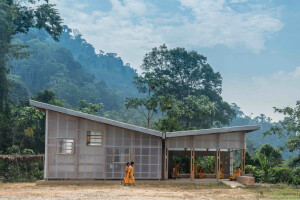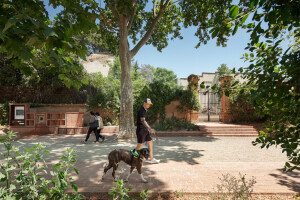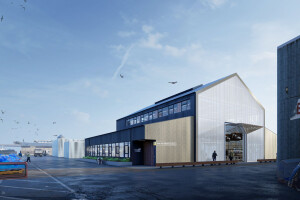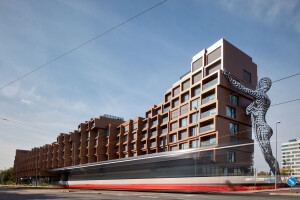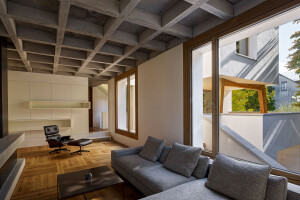Switzerland-based architecture studio Conen Sigl has transformed a former plant nursery plot near Zurich into a vibrant cooperative housing project. 'Westhof Dübendorf' is situated in an area that was once an industrial and commercial zone but which has been rezoned for residential use. The project blends historical inspiration with modern ecological design, with the ambitions of fostering a strong sense of community and connectivity among residents and with the greater neighborhood.
Three building volumes enclose a communal courtyard. The ensemble consists of a four-story head building, an angled three-story wing building, and a more prominent nine-story main building. The head building is rotated slightly in plan to create a clear entry point to the courtyard and enhance its openness to the neighborhood.
Drawing from the site's history and its previous structures, the architecture reflects simplicity and robustness. The architects also sought to make the development an active part of the local ecosphere, which includes a nearby nature reserve, by enhancing biodiversity and promoting sustainable urban living.
A social hub
The wing building’s flat roof serves as a semi-public terrace, envisioned as a social hub for neighborhood events and an exterior space for urban gardening. The rooftop is accessible via internal stairwells and an open public staircase from the courtyard, to promote easy access and community engagement.
An open pergola structure atop the terrace is both an architectural highlight and a functional element, reconnecting upper levels with ground activities. The building features soundproof glazing on its third floor to provide residents with noise protection.
The ground floor design balances public and communal areas with private zones. Commercial and community spaces are placed at the building's north and south ends. A café located in the south serves as a neighborhood gathering spot, complementing pedestrian and bicycle paths along the adjacent railway tracks.
Within the courtyard a greenhouse-inspired pergola structure expresses the project's strong, simple aesthetic. Balconies here feature a delicate steel structure which appear like lacework on the building and provide support for awnings and cladding.
A central passage through the courtyard leads to a multi-purpose room, creating a lively environment envisioned as a semi-public square. A strip of community gardens along the western pedestrian path offers residents a retreat for cultivation and relaxation and reinforces the project’s emphasis on communal space.
Materiality and ecological considerations
Westhof Dübendorf’s design pays homage to the site's horticultural past through its choice of materials and ecological features.
The facade, clad in large-format corrugated panels manufactured by Eternit, creates a dynamic interplay of light and shadow by giving the envelope a complex texture. According to the architects, the detailing of the facade is intended to communicate a seamless, wrap-around effect, akin to a dress enveloping the building and to accentuate a lightweight appearance.
The facade panels and their substructure are designed for future reuse. Produced in Switzerland, these ecological cladding panels also incorporate nesting aids for birds and other species, contributing to urban biodiversity. The landscaping is designed attracts insects and create a sustainable food source for birds.
The project is constructed with locally sourced materials and powered by renewable energy and has earned the Swiss Sustainable Building Standard (SNBS) certificate for sustainable design.
Flexible programming
Westhof Dübendorf offers 87 flats and six commercial spaces to cater to a diverse resident population. The flat types range from one-room units to cluster flats. The innovative use of 'switch rooms' allows for the combination of smaller flats into larger units, providing flexibility to meet changing needs over time. Additional communal amenities include flex rooms, a multi-purpose hall, and a guest room.
















